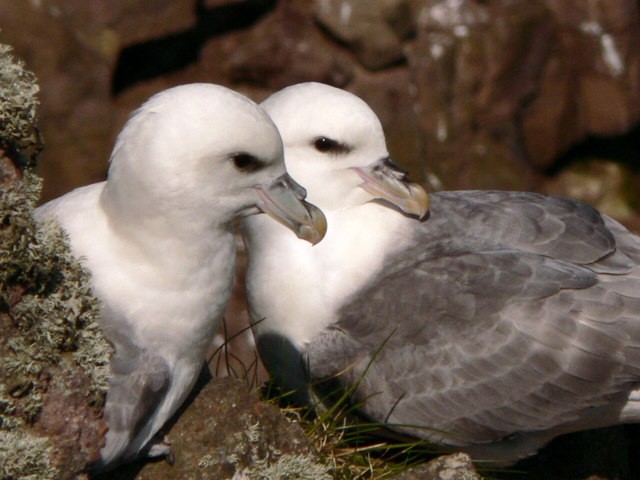Northern Fulmar
A species of Fulmars Scientific name : Fulmarus glacialis Genus : Fulmars
Northern Fulmar, A species of Fulmars
Botanical name: Fulmarus glacialis
Genus: Fulmars
Content
Description People often ask General Info
 Photo By AlastairG , used under CC-BY-SA-2.0 /Cropped and compressed from original
Photo By AlastairG , used under CC-BY-SA-2.0 /Cropped and compressed from original Description
The northern fulmar has a wingspan of 102 to 112 cm (40–44 in) and is 46 cm (18 in) in length. Body mass can range from 450 to 1,000 g (16 to 35 oz). This species is gray and white with a pale yellow, thick bill and bluish legs. However, there are both a light morph and dark, or "blue," morph; in the Pacific Ocean there is an intermediate morph as well. Only the dark morph has more than dark edges on the underneath but they all have pale inner primaries on the top of the wings. The Pacific morph has a darker tail than the Atlantic morph. Like other petrels, their walking ability is limited, but they are strong fliers, with a stiff wing action quite unlike the gulls. They look bull-necked compared to gulls, and have short stubby bills. They are long-lived, with a lifespan of 31 years not uncommon. 
Size
48 cm
Colors
Gray
White
Life Expectancy
34 years
Nest Placement
Cliff
Clutch Size
1 egg
Feeding Habits
Northern Fulmar feast on fish, squid, crustaceans, jellyfish, and carrion, diving several feet for prey or scavenging from fishing vessels and whale foraging areas. They’re opportunistic, consuming scraps and diverse prey like Arctic cod and amphipods, often feeding nocturnally.
Habitat
Northern Fulmar's habitat primarily encompasses the open seas of the North Atlantic, North Pacific, and Arctic Oceans. These birds are adept at navigating expansive maritime areas, favoring the presence of pack ice, convergences of currents, and upwellings for foraging. They are known to breed on sea cliffs in large colonies, residing in regions where oceanographic features like continental slopes and seamounts are prevalent. During the nonbreeding season, northern Fulmar often extend their range to temperate zones, reaching approximately 35°N latitude.
Nest Behavior
The timing of nest building by northern Fulmar varies by region, with egg-laying following suite. Both parents share the responsibility of incubating the egg and raising the chick.
Nest Characteristics
Northern Fulmar nests are simple depressions on cliffs or various other substrates, lined with minimal vegetation or pebbles, approximately 7.5 inches in diameter and 1.4 inches deep.
Dite type
Piscivorous
People often ask
General Info
Feeding Habits
Bird food type
Behavior
Northern Fulmars are highly monogamous, often bonding for life with impressive fidelity to both mate and nesting site. These seabirds socialize in dense colonies, exhibiting elaborate courtship displays involving head-wagging and cackling calls. Daily life is punctuated by frequent foraging trips, sometimes spanning over 600 miles to feed their chick. Post-nesting, northern Fulmars roam widely across the open ocean, following food sources that vary with the seasons. Their resilience is evident as they dynamically adapt their feeding locations to the changing availability of prey throughout the year.
Species Status
The northern fulmar is estimated to have between 15,000,000 and 30,000,000 mature individuals that occupy an occurrence range of 28,400,000 km (11,000,000 sq mi) and their North American population is on the rise, hence it is listed with the IUCN as Least Concern. The range of these species increased greatly last century due to the availability of fish offal from commercial fleets, but may contract because of less food from this source and climatic change. The population increase has been especially notable in the British Isles. 
Scientific Classification
Phylum
Chordates Class
Birds Order
Albatrosses and Petrels Family
Shearwaters and petrels Genus
Fulmars Species
Northern Fulmar